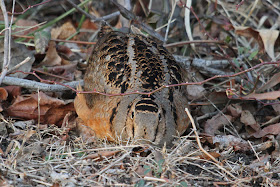In an ideal winter, woodcocks spend the day sitting quietly in lightly wooded areas, where their amazingly cryptic plumage makes them invisible to all but the most diligent searcher. At dusk, they fly out from cover to feed on damp, muddy ground in fields, meadows, even along roadsides and in gardens. But when the big freeze up comes, feeding opportunities for woodcock become very limited, as many of the invertebrates hide deeper below ground, or simply become impossible to get to in the rock-hard, frozen ground. For woodcocks, the easiest way around this is to seek out the few remaining unfrozen locations - where would this be? Well, salty water freezes at a lower temperature than sweet water, and we put a lot of salt on our roads when there is ice around. Put these two together and you soon work out that the most readily accessible, unfrozen areas around Cape May at the moment, are on roadsides.
A quick drive around your neighborhood should soon reveal the most likely-looking spots; look for damp patches on the side of the road, away from too much disturbance; also look for places where the sun hits for much of the day and warms the ground a little - the north side of an east-west road can be ideal. Now that you have your spot, what do you look for? Well, this is where the search image in your head comes in. Look at a picture of an American Woodcock in any field guide and you will see a perfect portrait of the bird - but that's not how you will first see them in the field. You need a search image, an image in your brain that you can carry with you and which your eyes will match. 'Ca-ching', there it is and the rest falls into place around it. So what is the search image for a woodcock? Well, it's likely that it will be different for some people, but for me, I home in on one of two things: the rusty-orange flanks, or the bars on the top of the head. Somehow these two features never quite seem to blend in with the surrounding landscape as perfectly as the rest of the bird and are almost always my first clues to a woodcock being present.
So, practice on a few photos in books or magazines; don't take in the whole picture but think about the parts that make up the whole. What strikes you as standing out from the crowd? Hold that image and take it with you next time you go out, and check those roadsides - some words of warning though: remember there may well be other cars on the road so be careful and be safe; also, remember that these birds are struggling on the edge in current difficult conditions. Always keep a respectful distance from the birds and never flush them. Sometimes they can be very approachable because they assume you can't see them because of their cryptic plumage; take your picture quickly if you have a camera, then back off quietly. The proof of success for you should be that the bird is still there when you leave.
Here's some pictures from this weekend in Cape May.
American Woodcock on Sunset Boulevard this weekend. The paler, orangey underparts contrast with the darker, mottled upperparts to create counter camouflage in the same strategy used by many fish species. It creates an image contrary to what we expect, since light generally comes most strongly from above and therefore the lower parts of objects are usually in shadow - and thus darker. All of a woodcocks colors are typical shades of the winter woodland floor, but that solid block of orange creates a good search image for you [photo by Mike Crewe].
Another American Woodcock on Sunset Boulevard. When seen head on, as in this feeding bird, the cross bars on the head seem contrary to the rest of the plumage and create a useful search image for me - two thick, dark brown patches with a pale line between [photo by Mike Crewe].
This bird was on Bayshore Road this weekend. Here we have a different, but still very distinct search image - a strong dark area with two, bright straw-colored lines across it. Rather different to a typical woodcock... [photo by Mike Crewe].
Here on Sunset Boulevard, again that solid dark area with pale, straw-colored lines. This is your search image for Wilson's Snipe, a close relative of American Woodcock. Snipe will also switch to roadsides during temporary freeze-ups, though more typically they are birds of well-vegetated wetlands [photo by Mike Crewe].
Wilson's Snipe are very flighty and usually it is best to give them plenty of space. Just occasionally though, you get one that trusts its camouflage and you get a rare opportunity to get awesome views of this fascinating bird. In this close up, the dark back pattern with pale tram lines can be seen more clearly [photo by Mike Crewe].




